Supersonic air travel is great if you want to get somewhere quickly. Indeed, the Concorde could rush you from New York to London in less than three and a half hours, over twice as fast as a conventional modern airliner. Despite the speed, though, supersonic passenger service has never really been sustainable thanks to the noise involved. Disruption from sonic booms has meant that supersonic travel over land is near-universally banned. This strictly limits the available routes for supersonic passenger jets, and thus their economic viability.
Solving this problem has been a hot research topic for some time. Now, it appears there might be a way forward for supersonic air travel over land, using a neat quirk of Earth’s atmosphere.
The Problem With Sonic Booms
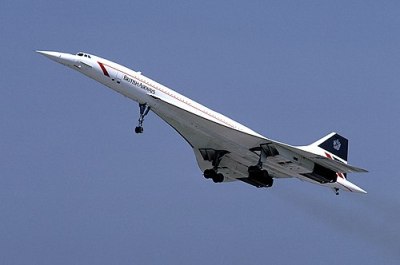
When supersonic airliners were first envisaged, the issue of sonic booms was recognized, but thought to be a minor one. Unfortunately, public opinion soon made it clear that wasn’t the case. As research and military aircraft began to punch through the sound barrier, the resulting sonic booms over populated areas lead to widespread complaints and even property damage in some cases.
As the Concorde developed, hopes remained high that the issue wouldn’t be insurmountable. In 1969, British Aircraft Corporation noted that they “do not expect that its sonic boom will be unacceptable to the great majority of the public.” However, in the face of widespread protest and opposition, the writing was on the wall. The world’s first supersonic airliner would be hamstrung by regulations, almost solely able to use its Mach 2 party trick on stretches of open water.

By the time of the Concorde’s initial revenue flights in the 1970s, the sonic boom was well understood. A plane pushing through the air is much like a boat pushing out bow and stern waves as it moves through the water. As a plane approaches the sound barrier, the pressure waves emanating from the aircraft get closer and closer together. At Mach 1, they effectively collide, and form into a single large shockwave. As speed increases, a characteristic shock cone is formed, with its apex at the nose of the aircraft.
To a stationary observer on the ground, the passing shockwave appears as a fast, large rise in pressure, followed by a significant negative pressure, before returning to normal. This is referred to as an “N-wave,” due to the characteristic shape the sonic boom leaves when graphed out.
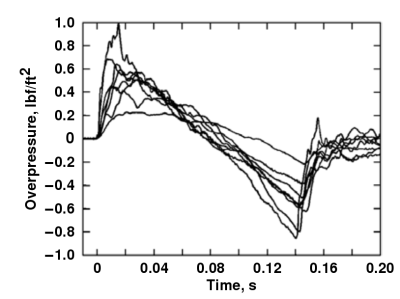
The positive pressure spike followed by the negative pressure spike are what creates the auditory “double boom” heard by observers. The overpressure from a sonic boom is great enough to cause minor damage such as shattering glass windows on buildings under the flight path.
The loud noise also typically creates great annoyance to those in the affected area. When an aircraft is flying at altitude, it can create an uncomfortable sonic boom that covers a wide stretch of land under the flight path, dependent on altitude, and it continues to do this for as long as it flies faster than the sound barrier. The affected area is typically referred to as the “boom carpet” for this reason.
Bending The Booms
If engineers were able to reduce the volume of a sonic boom or otherwise redirect it, supersonic travel over land would no longer face public or regulatory opposition. For this reason, a great deal of research has been undertaken into ways to mitigate or eliminate sonic booms created by fast-flying aircraft.
A particularly promising area of research has involved the theory of the “Mach cutoff.” The idea is that the pressure waves of a sonic boom could be redirected away from the ground by using the properties of the Earth’s atmosphere.
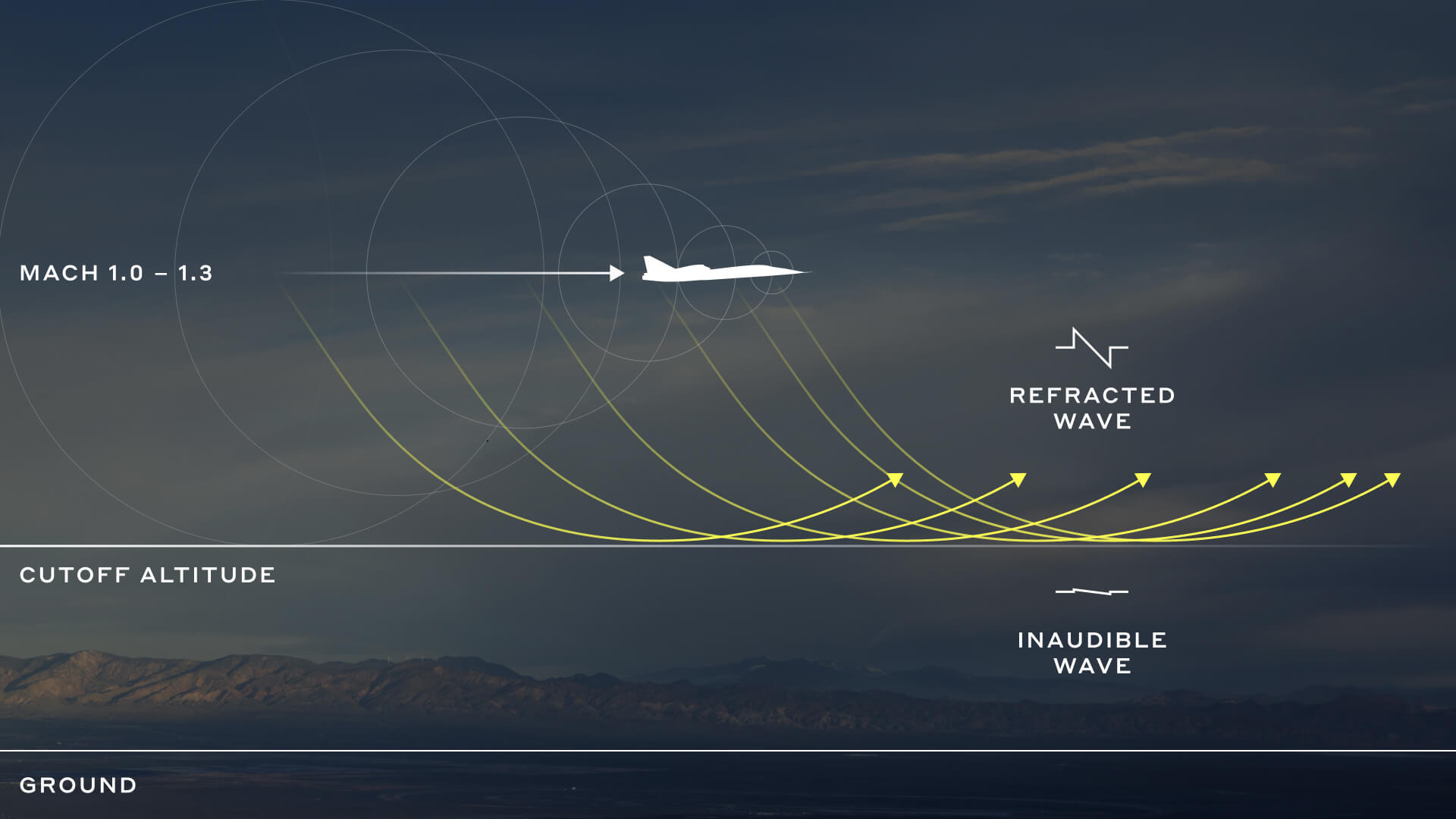
A sonic boom is effectively just a powerful pressure wave, and thus, like any wave, it’s subject to refraction. This is where a wave’s path bends when it travels through different media at different speeds. For example, light waves bend when they travel through air and water, because the speed of propagation of light is different in each. The same is true of sound travelling through air at different temperatures. At lower altitudes, the air is typically warmer and sound travels faster. At higher altitudes, the air is cooler, and sound travels slower. Thus, as the pressure waves travel downwards from an aircraft at high altitude, they reach the warmer air and are refracted, tending to bend away from the ground. The idea behind the Mach cutoff effect is to find a combination of conditions where the sonic boom is refracted such that it never hits the ground. The Mach cutoff itself refers to the critical altitude below which the sonic boom is effectively not heard.
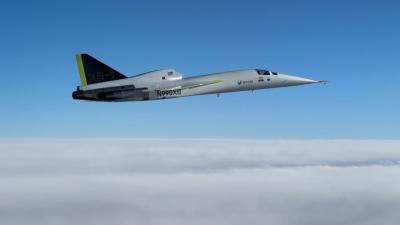
This technique has been the focus of research by Boom Technology, a company aiming to bring back supersonic air travel. Working with NASA, the company has been running tests with its Boom XB-1 test aircraft. Earlier this year, the company successfully attained supersonic flight without the sonic boom reaching the ground. This was confirmed by microphone arrays under the flight path, which verified there was no characteristic N-wave or pressure spike hitting the surface as the XB-1 flew multiple passes overhead. Test flights in February saw the company’s test aircraft hit top speeds of Mach 1.12 without a sonic boom hitting the ground. The company hopes to use the learnings from these tests to guide the development of the Boom Overture, a full-sized supersonic passenger airliner.
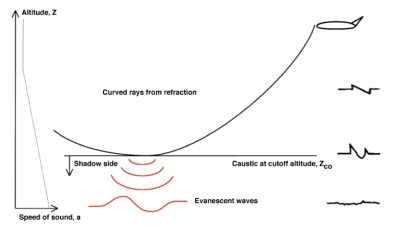
However, using the Mach cutoff technique is not a perfect solution to supersonic travel over land. The problem is that it’s highly dependent on ambient conditions. The local temperature, atmospheric pressure, and prevailing winds can all affect the local Mach cutoff altitude.
Thus, to fly supersonic in this manner requires a flight system capable of monitoring local conditions and keeping the aircraft’s flight parameters in the region where Mach cutoff is possible. Research by NASA has also indicated that it is not possible to exploit this phenomenon at very high speeds. Above Mach 1.3, it’s not realistically possible to refract the sonic boom enough to have it miss the ground.
These factors mean that even when exploiting the Mach cutoff, there would be some limitations on supersonic flight over land. Most commercial airliners fly at Mach 0.75 to Mach 0.85. Boom’s hypothetical future airliner could maybe top out at Mach 1.3 over land to avoid sonic booms hitting the ground. This would still net some serious speed gains—but perhaps only slashing travel times by 40-50% on overland routes. Boom expects that it could achieve a flight from San Francisco to New York in 3 hours and 30 minutes, versus over 5 hours for standard airliners today.
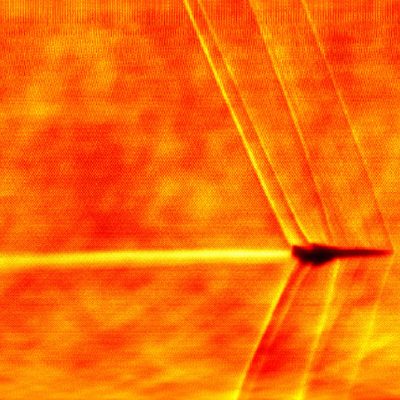
Fuel use is also expected to be very high in the supersonic flight regime, thanks to the extra drag experienced at higher speeds. There is also reason to believe that different routes might face very different conditions.
A study by the University of Pennsylvania used atmospheric data to determine that the maximum speed for Mach cutoff was much higher for westbound flights across the continental US versus eastbound flights, thanks to typical prevailing weather conditions over the country and their effect on the local speed of sound.
In any case, Boom still plans to ensure its airliner is capable of achieving up to Mach 1.7 when sound is not an issue, which would make it at least comparable to the Concorde’s top speed of Mach 2.04 when travelling over open ocean.
As far as supersonic passenger travel goes, things are currently looking brighter than ever. There is now a potentially viable technique for airliners to fly faster than the sound barrier over populated areas. However, the economics and practicalities will still have to work out if we are ever to see a supersonic transport in revenue service ever again.

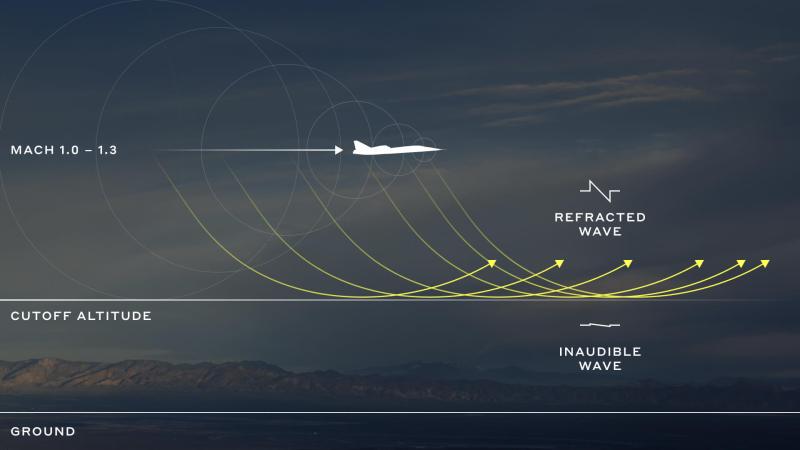













Ugg.
Commercial supersonic again. This time in a fun-sized private jet format.
I don’t mean to be “that guy”. I love technology, I love aerospace stuff. I love things that go boom. But the biggest problem with supersonic flight has always been the incredibly bad fuel efficiency.
Yes, the Concord had severe route limitations because of sonic booms over land, but ultimately it failed not for technical reasons but because it’s fuel burn rate rivaled that of a 747.
Now we’re talking about a machine that will realistically be used as a private plane, because despite what Boom says publicly, it will always be too expensive per passenger to make commercial sense.
These machines will spend their lives moving at most a handful of people at a time while chugging through jet fuel (and spewing CO2) like a 737. All so a few gazillionaires can cross the country 60 minutes faster.
Yay. Progress.
+1
Yeah I’m in the same boat (plane?). I’ve designed and built machines that will build (maybe, or at least follow-on product generations will) portions of these aircraft if they go to production, and have always been in love with aerospace engineering, even if it’s not my specialty. However, this is so much effort going into another toy for the rich. Why can’t we shift our effort to things that improtthe human condition?
Nice. With this tech, people proclaiming the evils of climate change will be better able to attend protests on the east and west coasts on the same day.
Growing up in a rural agricultural area 30-some miles from an air force base (fielding certain black supersonic aircraft) in the 70’s, I thought sonic booms were cool. I’d probably still think they are cool, but I’d probably now ask them to stay off of my lawn. :-)
I guess I really don’t know/remember which planes caused the sonic booms we used to hear, but it’s more fun to think they were from a sleek, black, titanium craft rather than an aluminum can full of business travelers in suits and ties.
I can’t claim any authority about the Concord engines, but weren’t they inefficient in addition to all the points you’ve mentioned? I seem to remember articles published on its demise mentioning that several times.
I can claim to be an expert on those engines!
I could write you a whole article on how incredible they were, but the short version is that if we were make a new engine for the same conditions again today, we would end up remaking the Olympus.
Basically, the majority advancements in jet engine technology in the last 50 years has come from two areas – bypass ratio and overall core compression ratio. In other words, jets have gotten bigger fans, and hotter cores.
However, the core compression ratio of the Olympus was already about 50:1 – which is competitive with modern engines. This was due to the “free” compression from the supersonic inlet.
And the ideal bypass ratio for Mach 2.0 is 0 – i.e. with no fan at all, which is what the Olympus had.
So new engines would be no better.
Interesting, thanks! I guess I have some reading to do on bypass ratios vs speed.
Came here to say this, the whole supersonic commercial flight industry (all 3 or so companies I guess…) is whistling and looking away from the real reason passengers don’t fly supersonic: because few of them have the bottomless pockets required to cover the fuel costs.
It’s easy to hate hypothetical gazillionaires in hypothetical supersonic jets that don’t even exist yet for their future hypothetical emissions, but are you brave enough to hate the currently-existing and very real Chinese?
Environmentalism is necessary but unfortunately it’s mostly gunked up with very easy social signaling; none of it matters unless we’re also willing to enforce it on people which you are very uncomfortable to use force against. The US is already below WWI levels of emissions per capita right now btw.
And before responding remember that we’re talking about a trend that extrapolates into the future, not the present snapshot of data right this second (or, more likely, some old data you find on google from the 1990s or perhaps 2000s)
them united states still emits over twice the amount of CO2 compared to what it emitted 1918. If one views the emissions per capita, yankee doodle dandy is by far the worst polluter on this planet, spewing out roughly twice the amount of europe and central asia recently. So blaming the population richest countries in the world is morally deplorable when one pollutes the most per capita. Once one is off the top 10 list, one can start coughing and huffing about china.
It would make more sense to go to space (only a 100km trip here), reach mach whatever absurd, and fallback to cow’s land. That would mean bringing your oxygen with you, through, but that shouldn’t pollute the people environment much (I’m talking about noise environment) except for the launch and landing area. In sort, I hate to say this, but SpaceX idea of reusing rockets for fast travel on Earth.
There’s no need for reaching space at orbital speed if you don’t intent any space application, I think, so the design for the motor and the experienced acceleration can be acceptable for the majority of us.
100% agree. The tech and science behind this is cool, the ultrarich guzzling fossil fuel at insane rates is very Not Cool.
Yeah your right. The biggest problem i see in a non-private format is it doesnt make sense to wait a few hours for the one “special” fast flight of the day if you can board the normal plane and get their earlier. If you need to get from one place to another within a certain time span all you can do is pray the supersonic flight it planned for that exact time.
Sure there are a few people who just want to minimize their time in the air and will pay a premium for it but they are just too few and far between.
Of course, there are already hundreds of commercial airliners out there flying around as personal aircraft…
https://businessjets.boeing.com/
… so what the heck zillionaires, go for it, get there 40 minutes faster.
I really have to wonder if the ultra-rich, used to the space and luxury of a converted commercial liner or something like a Global 7500 or a G800 would accept a relatively small cabin size and likely far less luxurious interior just for a small time gain in travel time.
Hubris.
They’ll get them simply because they can do in the stupid-money competition. Who wouldn’t sell shovels in a gold rush like that?
I can’t recall anything very useful in modern living that didn’t start as being “for the rich”. They are the ones that pay for and popularize things that later become cheaper and more widely available.
Uh, no. Please. Rich people have all the time in the world to travel, they don’t need to got faster. It’s all just bragging rights now. How about a society where every had enough holiday / vacation time that they go go in slower, more efficient , and socially engaging/responsible methods of travel. Bring back real train travel and transoceanic passenger liners.
The one billionaire I’ve personally known worked way more than any other human I’ve ever known. And would usually fly commercial but occasionally would get a jet when the time actually mattered to go, come back, and keep meetings.
Everyone is complaining about taking forever at the airport on either end; the jet crowd had the jet waiting for them and doesn’t wait in line like the rest of us suckers. There is even a, for lack of a better term, rich person separate terminal to facilitate this though with my limited experience (friend is a charter pilot) it’s more usual to pull up to the gate, get out the car and walk onto the plane.
The time savings to also avoid connecting flights and layovers when your own plane goes right from A-B at your whim is significant. When closing $MMM or $B deals the cost of private jet is a drop in the bucket.
It’s a whole other world for these folks.
Crazy how billionaires have to be in-person for meetings but can’t even spring for employees to go to training anymore because Teams exists. Commoners have to do everything remotely, no hotel stays or comp’ed restaurant meals for us anymore. I wouldn’t mind eating at Teipei 101 every week like my CEO does.
Let’s not forget the time it takes to get through airport security. A lot of air trips, I’ve spent almost as much time at the airport as in the air, or at least it feels that way. Fixing the airport delays would save as much time as making the plane supersonic.
And pay more people? UNACCEPTABLE!
i remember i had to go on a puddle jump flight. but i came back on the fast ferry. the ferry took 4 hours spending very little time at the ferry terminal, no security just grab your ticket and get on the boat. the flight was maybe 1:30 minutes, but an hour at the tsa line, and half hour at the baggage claim, and a good half hour walking the airports. flying saved me 30 minutes. though that’s not worth the extra legroom, no standing in lines, and simply being able to deal with my own luggage. the walk from the boat to the street took me less than a minute.
People with their own jets or even pedestrian single engine aircraft owners do not wait in line for security. They pull up, get on the jet that’s waiting for them, and leave.
Yep. A private jet usually departs from a private terminal on the other side of the airport, well away from all the TSA & Duty-free delays.
I am wondering what really happened around the Concorde back then. My best guess is that american airplane manufacturers did not like it, started lobbying real hard and aroused the public, with the result that the noise of the Concorde was grossly magnified out of proportions.
But also, Concorde was an amazing plane, but it never was a real success. Apparently a bunch of the planes were subsidized to the point they were almost given to airlines for free, but still, they needed about 3x the amount of fuel and there were very few people who have enough money so they don’t care about ticket prices if it gets them to their destination a few hours quicker.
I once flew from the Netherlands to Spain. The flight from Amsterdam to Barcelona was a bit over an hour, but the whole trip took a whole day.
* An hour and a half or so for the train to Amsterdam.
* Over an hour for checking in and customs.
* Bit over an hour for The flight to Barcelona.
* One or two hours waiting for an inland flight in Spain.
* Half an hour waiting for luggage.
* Nearly an hour for the taxi from the airport to a little village where the company I worked for had reserved a hotel.
A “faster plane” would not helped much at all. It’s all the other stuff you have to deal with.
A brother of mine once flew from Amsterdam to Sidney. Doing that with a gas guzzler would have been horribly expensive, and the extra hops for refueling would negate most of the time saving, and aerial refueling is not a real thing in passenger flights. The only thing that could work here are ballistic flights that hop outside of the atmosphere, but we’re not there yet. My guess is that supersonic flight will have a small window in time where it could be happening. I guess that 20 to 40 years from now ballistic flights may become a possibility. (That is, assuming the whole western world keeps on working, and we finally start making something great instead of smashing each others heads in).
That and Boeing figured out that it is cheaper to slow down a bit but stuff as many herrings, pardon, humans into a can as possible to squeeze more profit in the process. Seats were put closer to each other so more passengers can fit into the same space. Also, the three-classes seating was introduced – the cheapest seats now resemble a school bus as far as the legroom goes.
Same reason why US houses suddenly became no longer affordable. Canadian, too, btw, because the same can-stuffing “investors” generally don’t care about what average Sam needs for the price he can afford.
Markets, meh, there are no markets when Boeing and Airbus are the only two long-term monopolies standing. Just like Verizon and Comcast, eh, competition, no, what competition. There are no longer markets that could weed out the meek – that dream died out when PanAm folded (btw, another long-standing monopoly that basically collapsed under its own managerial weight).
Concorde was the step in the right direction at the right time, keynesian step, btw, not aynrandian. Government heavily invested and subsidized the future of air travel expecting that at some point the momentum will be strong enough to be completely offloaded to the profit-making entities that would R&D the rest. Government planners did not foresee the step backward that would be made by the creative accounting basically freezing and then eventually rolling back their investment.
This is not the entire picture.
Concorde came at the crest of the successful ticket pricing deregulation. Literally, prices were kept artificially low, so that the airlines would shake loose from their profit-extracting slumber, and start innovating. And innovating they did, air travel was kept affordable to the masses (before regulation only few could afford airplane ticket – during regulation – almost anybody – deregulation removed the shackles, so airlines could charge anything they want), and since airlines couldn’t squeeze profit from high rollers, they went for investing into better planes, larger airports, better service, etc etc. Optimism was unbounded, and it was rightfully viewed that the momentum will continue on, given that the pricing is no longer capped, and some of the astronomical profits will be invested into the R&D.
Little did they know that bean-counters would sooner or later start diverting larger and larger parts of profits from R&D into mostly unproductive/pointless things like stock price keeping or just plain vanilla lining pockets of CEOs. IMHO, 747 was one of the last true revolutions (747 was so large, it REQUIRED larger runways, differently trained dispatchers/flight-controllers, etc), though, in some ways it was a step backwards (slowing down the travel speed) and setting up the stage for the solidification of the direction of R&D – from now on it will almost always go towards extracting more profit at any cost (recent troubles with Boeings doing this and that due to engineers told to cut corners everywhere – that’s the DIRECT result of bean counting, not R&D).
Meh.
Cool tech and there’s probably a use case that I’m not thinking of right now, but SFO is my local airport, and I often nest my family in Brooklyn NY. The travel time from home in California to my family in Brooklyn is only a bit more than 50% in the air. I think most trips in the USA have a much worse ratio of flying time to total travel time.
So if you cut flying time in half by doubling speed you would at best cut travel time time by 25 percent. But it’s nowhere close to doubling speed, you have to take off and get to altitude before you grab the go-fast lever and have to slow on approach.
So on a transcontinental flight it is a dubious proposition at best, and on any thing shorter it’s ridiculous.
The best investment in cutting travel time would be making it faster to get to and from the airplane. Get rid of the useless TSA screening ( if I were a terrorist, and wanted to immediately shut down the airlines and kill a dozen airliners worth of passengers at a time, a bomb going off in the line where they check for bombs would do it. Three airports at once and air travel would be dead. The TSA checkpoints are actually a vulnerability not a protection, but I digress)
Of course speedy public ground transportation is the other key to shortening travel time. Dealing with your own car at the airport , I didn’t factor that in, is crazy. Dealing with rental cars truly makes air time insignificant.
The only thing I would get excited about in airliner design would be to lengthen the squab of the seats and angle it up a little, or make the planes more efficient.
The speed of the aircraft isn’t even in the top ten of improvements I’d get excited about.
Cool tech, and great article though.